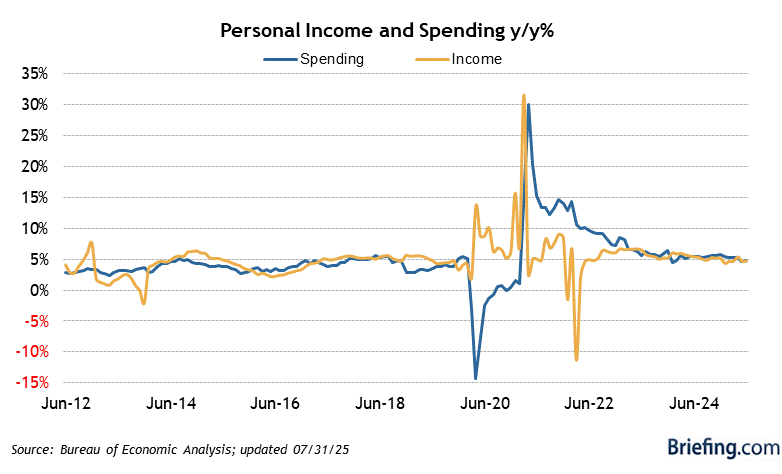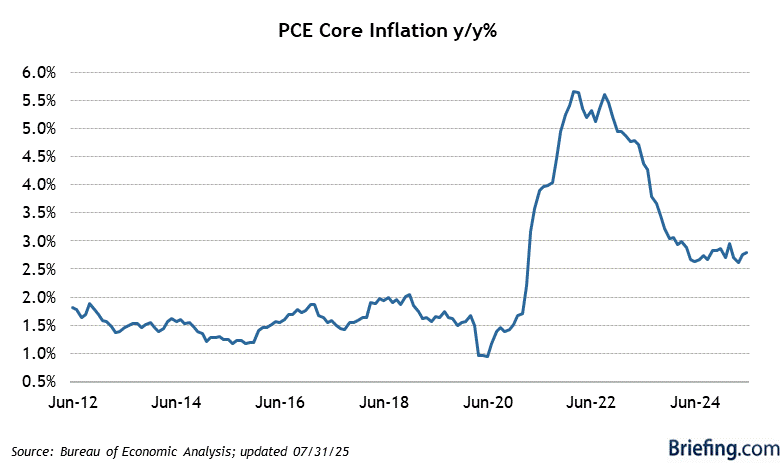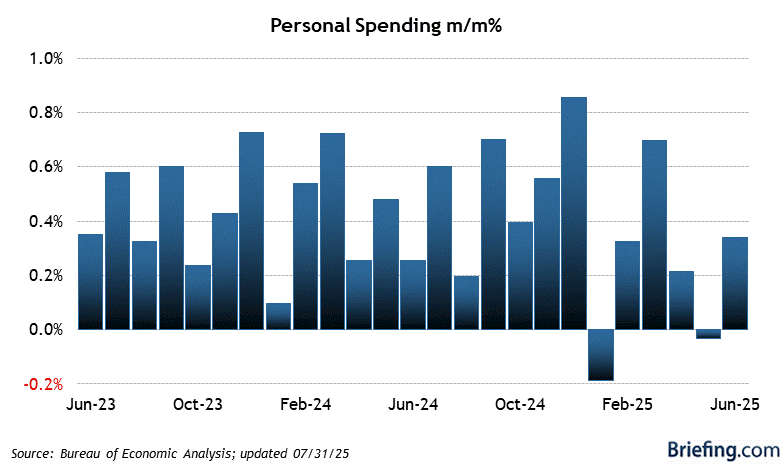Updated: 05-Dec-25 10:40 ET
| September Personal Income and Spending |
| Updated: 05-Dec-25 10:40 ET |



Highlights
- Personal income increased 0.4% month-over-month in September (Briefing.com consensus: 0.4%) following a 0.4% increase in August.
- Personal spending jumped 0.3% month-over-month (Briefing.com consensus: 0.4%) following a downwardly revised 0.5% increase (from 0.6%) in August. Real PCE, though, was flat.
- The PCE Price Index was up 0.3% month-over-month, as expected, and the core PCE Price Index, which excludes food and energy, was up 0.2% (Briefing.com consensus: 0.3%).
- On a year-over-year basis, the PCE Price Index was up 2.8%, versus 2.7% in August and 2.3% in April, and the core PCE Price Index was up 2.8%, versus 2.9% in August and 2.6% in April.
Key Factors
- The PCE Price Index for Goods was up 0.5% month-over-month and up 1.4% year-over-year versus 0.9% in August.
- The PCE Price Index for Services was up 0.2% month-over-month, leaving it up 3.4% year-over-year versus 3.6% in August.
- Wages and salaries increased 0.4% month-over-month after increasing 0.4% in August.
- Rental income was up 0.1% month-over-month after increasing 0.2% in August.
- Personal interest income was up 0.4% month-over-month after increasing 0.4% in August. Personal dividend income was up 0.9% month-over-month following a 0.4% decline in August.
- Real disposable income was up 0.1% month-over-month and was up 1.9% year-over-year versus 2.0% in August.
- Real personal spending was flat month-over-month and was up 2.1% year-over-year versus 2.6% in August.
- The personal savings rate, as a percentage of disposable personal income, held steady at 4.7%.
Big Picture
- The key takeaway from the report is that it revealed a very sticky inflation component that remains well above the Fed's 2.0% inflation target. That likely won't prevent the Fed from cutting rates next week, but it will likely factor into a "hawkish cut," as the Fed implies it will be inclined to wait longer for the next rate cut.
| Category | SEP | AUG | JUL | JUN | MAY |
| Personal Income | |||||
| Total Income | 0.4% | 0.4% | 0.5% | 0.3% | -0.4% |
| Wage and Salary | 0.4% | 0.4% | 0.6% | 0.1% | 0.4% |
| Disposable Income | 0.3% | 0.4% | 0.4% | 0.3% | -0.5% |
| Savings Rate | 4.7% | 4.7% | 4.9% | 5.0% | 5.2% |
| Personal Consumption | |||||
| Total (Nominal) | 0.3% | 0.5% | 0.5% | 0.5% | 0.0% |
| Total (Real, Chain $) | 0.0% | 0.2% | 0.4% | 0.3% | -0.1% |
| Core PCE Deflator | |||||
| Month/Month | 0.2% | 0.2% | 0.2% | 0.3% | 0.2% |
| Year/Year | 2.8% | 2.9% | 2.9% | 2.8% | 2.8% |